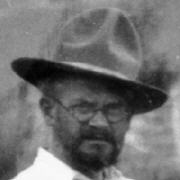
Walter Ufer was born in Huckeswagen, Germany. At the age of four, Ufer moved with his family to Louisville, Kentucky, where he grew up. His father was a master gunsmith noted for his fine engraving work. Though Ufer's formal education did not extend beyond grammar school, his promising artistic talent led his father to apprentice him to a commercial lithographer. At age seventeen, Ufer followed his mentor to Germany, working as a journeyman printer and engraver. He soon decided to pursue a career as a painter and enrolled in the Royal Applied Art School and the Royal Academy, both in Dresden.
By 1899 Ufer had returned to the United States to settle in Chicago. He continued his studies at the Art Institute while supporting himself as a commercial lithographer and engraver. In 1911 he married a Danish-born artist, Mary Fredericksen. The couple returned to Europe for two years, traveling extensively and studying with Walter Thor in Munich.
After returning to Chicago in 1914, Ufer, along with fellow artist Victor Higgins, was commissioned by art patron Carter Harrison to paint at Taos. Both men were captivated by the little village and decided to stay. They were invited to join the Taos Society of Artists and became full members in 1917. Though the Ufers travelled extensively, Taos was their home until Ufer's untimely death in 1936.
By all accounts, Ufer was a colorful personality. He was a generous, outspoken man with a sensitive social conscience. During the flu epidemic of 1919, he worked day and night alongside the town's only doctor, ministering to the sick.
Ufer was the first New Mexico artist to win a prize at the Carnegie International. Included among his other numerous awards are the Chicago Art Institutes's First Logan Prize, the Isidor Gold Medal, the Pennsylvania Academy's Temple Gold Medal and the National Academy of Design's Altman Prize, which he won twice. Ufer's brilliant, boldly painted compositions are distinctive images of the Taos Indian surrounded by the magnificent landscape of the region.